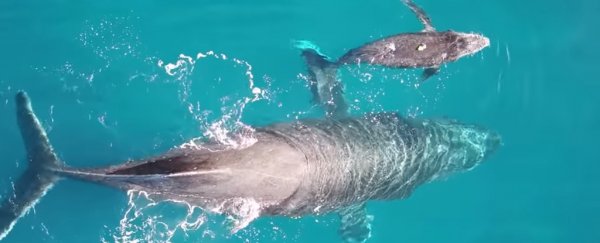Whales, as we all know, are different from most other sea creatures. They are mammals, and give birth to live babies… and then they nurture and raise those babies, nursing them on rich, fatty milk so they can grow big and strong.
But we can't just put whales in an aquarium and watch them raise their families. They are large beasts with complex societies, and their migration can take them around the world.
While the ocean isn't exactly hospitable to humans, though, we can send our technology. Through the use of whale-mounted cameras, scientists from the University of Hawaiʻi, Stanford University, and UC Santa Cruz were able to capture breathtaking video of humpback whales nursing their calves as they wintered in their breeding grounds in Maui.
Every year, around 10,000 humpback whales return to these warm, shallow waters to birth their young. The mothers will then spend a few months - from January to March - raising their calves, strengthening them for the migration to their krill-rich summer feeding grounds in Alaska.
During these winter months, the mothers don't eat, living - and feeding their calves - off their blubber stores. What the research team wanted to know is how often and for how long the calves feed, in order to be strong enough for the spring migration.
They put a number of technologies to work. Non-invasive sensor arrays - including acoustic recorders, accelerometers, pressure sensors and, of course, cameras - were attached to seven humpback whale calves via suction cups.
The team also used drones to fly over and observe the whales from above.
"We can actually see what these animals are seeing and encountering and experiencing themselves," said marine biologist Lars Bejder of the University of Hawaiʻi's Marine Mammal Research Program.
"Itʻs quite unique and rare footage that we're obtaining, which is allowing us to quantify these nursing and suckling bouts that are so important."
The two data sets - from the sensor arrays and the drones - allow the researchers to better understand what the whales are doing. The drone video provides an overarching picture of the interactions between a group of whales, and the whale-mounted sensor array adds granular detail for a much more complete understanding of those interactions.
It's not just for nursing behaviour, either. Last year, Bejder and his team spent some time in the Alaskan feeding grounds, where they obtained an absolute treasure trove of data on the bubble nets the whales use to hunt their prey.
During last year's breeding season, he also managed to use a drone to capture a newborn humpback whale, swimming next to its mother in Maui, less than 20 minutes after its birth.
He and his colleagues are hoping that all this data collection will lead to a greater understanding of the lives of these incredible animals, and the role their migration plays.
"Combining these data sets across the foraging and the breeding grounds is really going to tell us something about the importance of these different habitats for these animals," Bejder said.
Plus, it's really, really freaking cute.
